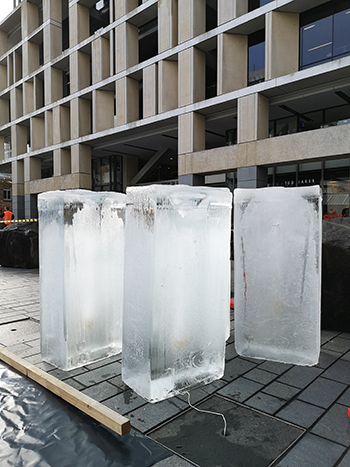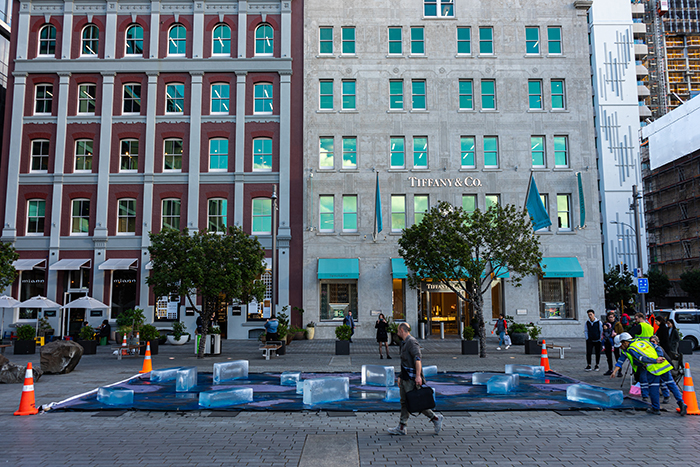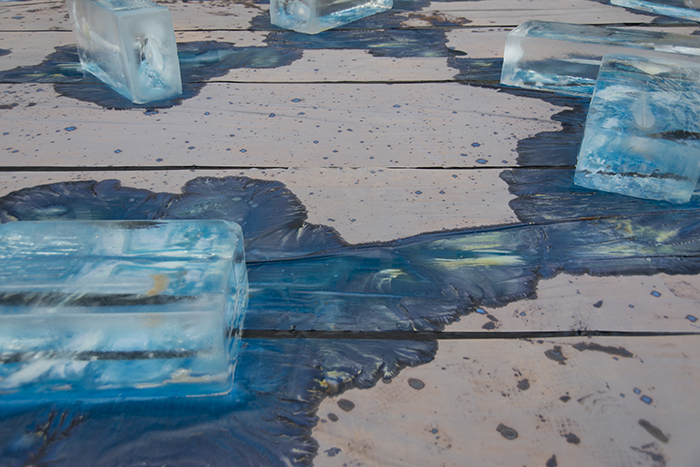Jessica Chubb and Jonathan Kay

Jonathan Kay, Negative Mass, 140kg blocks of ice, (2 tonnes ice in total), Takutai Square, Britomart, Auckland.
There is a solid stillness to ice. Ice molecules are latticed together in a patterned and steadfast way. It is sure in its unadulterated coldness. There’s even a dryness to ice in its home environment. It feels proud and determined. Time stands still. Underneath this illusion of stillness, glacial ice morphs and moves, giving-in under the pressure of its own weight. It persists and struggles in equal measure.

Jonathan Kay, Negative Mass, (2019), Cyanotype photogram on cotton and ice, Takutai Square, Britomart, Auckland, 10 -13 July.
Jonathan Kay’s work Negative Mass moves from installation, through performance and spectacle, to a photographic investigation of interrelationships between science and art. It centres on a deceptively simple concept. It is made with simple materials, but speaks to a poignant and layered issue we are confronted with on a global scale. In simple terms, it speaks of cause, effect, and the transformation in-between.

Jonathan Kay, Negative Mass, (2019), Cyanotype photogram on cotton and ice, Takutai Square, Britomart, Auckland, 10 -13 July.
Key to this work, and to the practice of this artist, is connection to place. Kay’s previous work with Aotearoa’s larger glaciers; Te Moeka o Tuawe (Fox) and Haupapa (Tasman), have engaged similar simple techniques of laying light-sensitive fabric in contact with the icy surface. In doing so, Kay has given a unique voice to the glaciers.
Cyanotypes were an early means to ‘accurately’ document nature. Often used to create records of exotic botanicals, such as in the work of 19th century English botanist and photographer, Anna Atkins. Creating a cyanotype relies on three basic things to produce an accurate analogous image; a light sensitive surface, a light source and contact. Whatever stands or sits between surface and light will create a negative form on the fabric. In this project, I propose that Kay’s use of the cyanotype speaks less to scientific accuracy of form, and more to scientific poetry of form. The story told, evokes an emotional response as well as intellectual dialogue. It engages with legacies of beauty and scale in relation to the sublime in nature. The work illustrates a transformation with visual prose made from contact and reaction, in a way wholly different from an orthodox photograph.



Jonathan Kay, Negative Mass, (2019), Cyanotype photogram on cotton, Atrium on Takutai Square, Britomart, Auckland, 10 July – 7 September.
This work activates thought on and around a known climate crisis, but also points to the role we play as spectators, mark-makers, artists, writers, social commentators. As the marks made in the work shift in delicate shades of icy-white and blue, there is an inference that the repercussions of our action/inaction too will make marks. As increasing numbers of artists globally demonstrate, there is, and has always been, an important role in the world for artists to play in activating activism, and giving voice and colour to matters of social conscience. The imperative is to interrogate our surroundings, and to especially share where it is found wanting.
These aspects of the work, located amongst a bustling city, are brought to the fore. By making this a spectacle in the public forum, Kay is highlighting a public responsibility and commentating on our own intrigue and curiosity, while emphasising the limitations we face as spectators. There is growing and significant support for the cause, but watching is all many of us will do.

Jonathan Kay, Negative Mass, (2019), Cyanotype photogram on cotton and Ice, Takutai Square, Britomart, Auckland, 10 -13 July.
There is an anxiety felt watching big ice melt. At our feet we see this icy lens sweat. It is stressed and perspiring. It is losing its bearings and increasingly anchorless. It is fraught with drama and tragedy, becoming more at odds with itself. This unfolds with a sad sense of inevitability and transformation.
At once the ice is dissipating and creating. It is survived by the marks it makes in the land and the story it tells to those that might read its purpose; a lament that says there was ice here once, but because the world changed around it, it could not stay. We can see the traces of the object it was, and the marks made as it perished, we see the cause and effect, and what is left behind. We see that it is beautiful, but not the same. It can never be the same.
Jonathan Kay, Negative Mass, (2019), Cyanotype photogram on cotton and Ice, Takutai Square, Britomart, Auckland, 10 -13 July.
Jonathan Kay is a photographic artist and lecturer in photography living in Te Whanganui-a-Tara/Wellington, Aotearoa/New Zealand. His practice focuses on blurring the boundaries of art and science to render the unseen and challenge notions of landscape. His methodology employs photographic interventions within the landscape that are site specific and responsive. Exhibitions include Negative Mass (Gus Fisher Gallery, Auckland), WAI – Manga Maha, Awa Kotahi | One River, Many Streams, (Aratoi -Wairarapa Museum of Art and History) Masterton and Nothing but Dust, (Wellington Museum). He completed a MFA with distinction at Massey University, Wellington, in 2013.
Jessica Chubb works with and within the photographic medium. Through practice she has explored photography as an extension of corporeal vision – in its complexity and its fragility, and continues to write on important contributions to the medium in the new and emerging space. Jessica completed an MFA with distinction at Massey University in 2013.